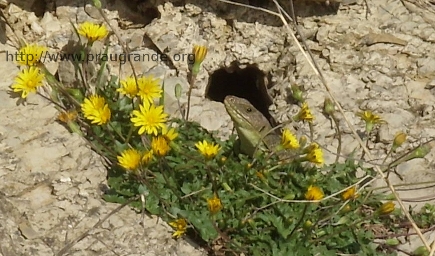Local fauna
reptiles :
* European green lizard (Lacerta viridis)
* Wall lizard (Podarcis muralis)
* Gecko (Tarentola mauretanica)
* Montpellier snake (Malpolon monspessulanus)
* Monpellier snake (Malpolon monspessulanus)
It is a dark-brown snake, quite common in the coastal area up to an elevation of 800 m.
 Its length can exceed 2 m. It is a poisonous snake, but its poison is not harmful for the man. Long ago the rural population appreciated its stewed meat.
Its length can exceed 2 m. It is a poisonous snake, but its poison is not harmful for the man. Long ago the rural population appreciated its stewed meat.
* Ocellated lizard (Timon Lepidus)
The Ocellated Lizard is the most significant species of the Site.
 It is the biggest saurian of the Italian fauna, very interesting from the bio-geographic viewpoint. It is present in Spain and in the South of France, and its distributional area in Italy is only in Liguria di Ponente, proving an ancient continental connection between North Africa, Iberian Peninsula, South of France and Liguria through the Strait of Gibraltar.
It is the biggest saurian of the Italian fauna, very interesting from the bio-geographic viewpoint. It is present in Spain and in the South of France, and its distributional area in Italy is only in Liguria di Ponente, proving an ancient continental connection between North Africa, Iberian Peninsula, South of France and Liguria through the Strait of Gibraltar.
Regione Liguria requested to include the Italian populations as priority species in Enclosure II of the directive “Habitat”, because its peculiar bio-geographic distributional area.
Males normally reach a length of 60 cm, sometimes even more. Their livery is green with blue “ocelli” that give the common name to the species. The young’s are brown with circular spots, brown on the back and light blue on the flanks.
The average lifespan is 6-7 years; the males reach the sexual maturity at two years of age, the females at three. It is a very shy reptile, with an escape distance of about 100 m, and in the most cases can be observed only with the binocular.
The Ocellated Lizard lives in the garrigue; in Liguria can be found up to an elevation of 500-600 m in open and grassy areas with rocks on which to lie in the sun for the thermoregulation.
Males and females live in couples, and the males actively defend their territory from other males. This saurian preferably eats insects, small mammals, birds and snakes, but also berries and fruits.
The environmental degradation, the fires, and the presence of human activities are the main causes of the decline of this species.
In Liguria the Ocellated Lizard is protected by the Regional Law no. 4 of 22 January 1992 “Tutela della fauna minore – Preservation of minor fauna”, and is included in the “particularly protected” species mentioned in article 11. Sanctions are provided against disturbing and capturing this species.
The presence of the Ocellated Lizard is one of the most relevant characteristics of Pompeiana SIC.
Increasing environmental protection actions in order to avoid the modification of the characteristic habitat is very important for the preservation and the enhancement of the Site
mammals
The mammal fauna in the Site is typical of the Mediterranean environment, and includes :
* wild pig (Sus scrofa)
* fox (vulpes vulpes crucigera)
* badger (Meles meles)
From the conservation viewpoint the most significant species are the Chiroptera :
* Rhinolophus Eurìale
* Rhinolophus ferrumequinum
* Rhinolophus hipposideros
These three species are included in the “Red List” of the Italian Vertebrates (WWF, 1998) : the first two as “vulnerable species” (high extinction risk in the medium term), the third one as “species in danger” (very high extinction risk in the short term).
The most disturbing factors for these species are the human presence, the pesticides and the pollutants on the soil.
All the Chiroptera are included in Enclosure II of the Directive “Habitat” as priority species.




